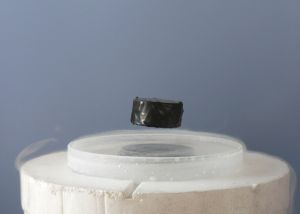
Over at Science Alert there is a story that appears on the surface to be quite exciting, “Physicists achieve superconductivity at room temperature“, ah but … (sorry, spoiler alert, the claim is sort of true, but there is a huge catch, so don’t get too excited).
First, let’s step back for a second as explain what we mean by the term “superconductivity”. Actually, Wikipedia explains it quite well, so I’ll simply steal borrow their description ..
Superconductivity is a phenomenon of exactly zero electrical resistance and expulsion of magnetic fields occurring in certain materials when cooledbelow a characteristic critical temperature. It was discovered by Dutch physicist Heike Kamerlingh Onnes on April 8, 1911 in Leiden. Like ferromagnetismand atomic spectral lines, superconductivity is a quantum mechanical phenomenon. It is characterized by the Meissner effect, the complete ejection of magnetic field lines from the interior of the superconductor as it transitions into the superconducting state. The occurrence of the Meissner effect indicates that superconductivity cannot be understood simply as the idealization of perfect conductivity in classical physics.
The electrical resistivity of a metallic conductor decreases gradually as temperature is lowered. In ordinary conductors, such as copper or silver, this decrease is limited by impurities and other defects. Even near absolute zero, a real sample of a normal conductor shows some resistance. In a superconductor, the resistance drops abruptly to zero when the material is cooled below its critical temperature. An electric current flowing through a loop of superconducting wire can persist indefinitely with no power source.[1][2][3][4][5]
Now that is exciting stuff, because if you could achieve superconductivity at room temperature then it is in so many ways a game changer – imagine a world of power distribution using wires with no resistance. Today the best we have is a tad tricky, because the materials involved are brittle ceramics which are expensive to manufacture and not easily formed into wires or other useful shapes, but even that is still applied. For example in 2008 there was the announcement of the $60 million Holbrook Superconductor project, the world’s first transmission power cable transmitting waves of electricity from the grid to a substation that feeds actual U.S. homes. It works well and so instead of power distribution pipelines into the city 200-300 ft wide, you have a corridor only four feet wide and 600 meters long. It is expensive because you have to cool it to minus 371 degrees using liquid nitrogen to enable it to carry 138,000 volts, but the alternative was to demolish some very expensive real estate, so a narrow 600 meter pipe instead of a 200-300ft wide one was a bargain.
To function over that 600 meters the -371 requirement makes it expensive, but if that low temperature requirement could be removed, the it all becomes rather a lot less expensive and far more scalable.
What is the catch?
OK, so the story is all about how some clever Physicists from the Max Planck Institute have successfully managed to achieve room temperature, and while the story does gush on about it all, they do come clean and explain in the second last paragraph what the catch is by quoting from the actual press release as follows …
The infrared pulse had not only excited the atoms to oscillate, but had also shifted their position in the crystal as well. This briefly made the copper dioxide double layers thicker – by two picometres, or one hundredth of an atomic diameter – and the layer between them became thinner by the same amount. This in turn increased the quantum coupling between the double layers to such an extent that the crystal became superconducting at room temperature for a few picoseconds.
Yes, they did it, but the effect can only be sustained for a few picoseconds.
Least you wonder, a picosecond is 0.000 000 000 001 of a second.
Do not misunderstand me, I’m not criticising the discovery itself, because that is indeed a fascinating discovery and so is to be applauded. Instead I’m mocking a story that hails the discovery of room temperature superconductivity and yet fails to tell you that they only sustained it for a few picoseconds until you reach the small print in the second last paragraph.
What we have is a step in the direction of the dream of room temperature superconductivity and also something that will help to to increase our understanding, and that’s the reality here.
So there you go then, you can indeed be excited because they really have achieved room temperature superconductivity, but you should perhaps also only sustain that excitement for a few picoseconds, and sadly that duration might not be long enough for your neurones to detect such excitement.
Links
- The press release
- The actual paper in Nature – Nonlinear lattice dynamics as a basis for enhanced superconductivity in YBa2Cu3O6.5 (sorry their paywall there)